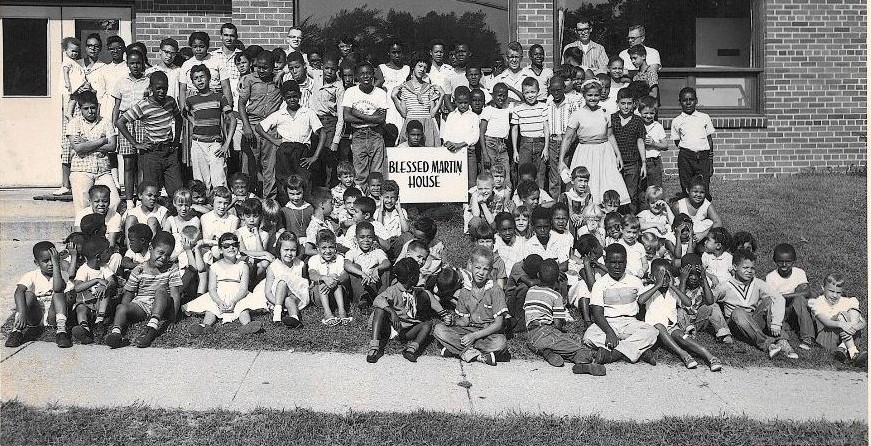On Beld Street, just a little bit away from the high traffic area of South Park Street, you’ll find the simple brick structure that houses the Catholic Multicultural Center that started in Madison in 1946. Father Jerome L. Hastrich (who later became Bishop of Gallup, New Mexico) established the organization with the goal of promoting interracial unity between blacks and whites.
To keep things in perspective on where race relations were in the United States in 1946, the United States Army was still segregated and would remain segregated until the Korean War. The famous school integration case Brown v. Board of Education was still nine years away.
A charity that believed in bringing black and white people together was rare for those time.
“It was a place where blacks and whites could come together at a time when that wasn’t really happening,” says Andy Russell, director of the Catholic Multicultural Center. “Madison was mostly white at that time but there were some African Americans, especially on the south side here. Originally, we were in a storefront that no longer exists in the Greenbush [Neighborhood]. We moved to this area in the ‘50s.”
Through humble beginnings, the volunteer-run charity set out on a mission to bring blacks and whites together and help those in need. Along the way it evolved into the organization we know today.
The Catholic Multicultural Center, or CMC, has gone through quite a change in 60 years. When they first started, they were called the Blessed Martin House, named after Martin de Porres, a Peruvian lay brother of African and Spanish descent that did charity works during his lifetime and stood for harmony among all living things.
As an illegitimate son of a Spanish gentleman and a freed African slave, de Porres himself met a lot of limitations during his lifetime during the 16th and 17th Century because of his mixed race. As a man dedicated to charity, Martin gave care and help to anyone without distinction regardless of whether they were Spanish or slaves.
“He was famous for his ability to get everybody to get along,” Russell says of de Porres, who is depicted by a statue in CMC’s chapel. “He was for interracial justice. The story goes that he could get a mouse and a cat to get along.”

Blessed Martin House through the years grew beyond community dinners and charity events to programs aimed at building community and social justice. In 1952, the volunteers of the growing charity house, along with Bishop Hastrich and his brother, generously built the charity a new home to house new programs for the community. Soon, the charity house changed its name from being The Blessed Martin House to St. Martin House as the pope in 1962 canonized Blessed Martin to sainthood and he became the new St. Martin de Porres, patron saint of interracial harmony. The charity house changed its name accordingly. The house moved from being entirely volunteer-driven to being managed by the Archdiocese.
As St. Martin House grew over the years, a separate charity organization came into being whose existence would soon be intertwined with St. Martin. With the arrival of more and more Spanish-speaking migrant workers in Wisconsin, Centro Guadalupe was formed to aid the Latino population. Cento Guadalupe provided legal assistance, language programs, and charity events. The two charities both worked alongside each other promoting social justice and improving Madison on Madison’s south side.
In 2002, the Archdiocese called for the volunteer-built building to be demolished and reconstructed to better suit the charity’s purposes. The organization of St. Martin now encompassed its services to include Latino needs as well as housing the new charity and taking on those duties.
The name had once again changed – this time to the Catholic Multicultural Center. The CMC became dedicated to “serving the whole person,” and providing a variety of services such as food assistance, health services, English classes, job development, immigration legal services, and children’s programs.
It was smooth sailing for the new Multicultural Center until six years ago when disaster struck as the center closed down in the light of a budget crisis from the Archdiocese. Fortunately, two months later, the place reopened under the new management of Our Lady Queen of Peace Church, a catholic church on Madison’s west side. Queen of Peace had its own committees and organizations under it and acquired the Catholic Multicultural Center as a part of its very own venture to give back to the community even more.

“Working with Queen of Peace … that really brought it back to the grassroots again. We have over 1,000 volunteers that make us run and have a large group of people who support us financially,” Russell says. “They have just been great.
“We’re here to serve the poor, but this is also a way for people to live out their faith,” Russell adds. “I feel like, speaking for myself, that any help I’ve given over the years as a volunteer or a staff member [at CMC] that I’ve received so much more from it. They’ve given me more than I’ve ever given them.”
Our Lady Queen of Peace allowed the CMC to be more flexible and gave them more freedom of choice within the CMC organization. With more freedom and attention came new ideas, new programs, and new ways of keeping the community in good hands. Right now, the Catholic Multicultural Center seems to have new programs springing up constantly led by Russell and Volunteer Coordinator Laura Green.
“Things are going great here,” Russell says. “We’ve been able to expand a lot of programs. We’ll be hiring our first English as a second language (ESL) person to coordinate those classes. We just received a grant for $50,000 from Washington D.C. for our culinary training enterprise. We’re taking over the Queen of Peace lunch program. Thing are going really well … we’re excited for the future.”










